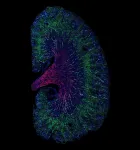(Press-News.org) WACO, Texas (June 21, 2021) - A new analysis of Venus' surface shows evidence of tectonic motion in the form of crustal blocks that have jostled against each other like broken chunks of pack ice. Published in the PNAS (Proceedings of the National Academy of Sciences), the study -- which includes contributions by Baylor University planetary physicist Peter James, Ph.D. -- found that the movement of these blocks could indicate that Venus is still geologically active and give scientists insight into both exoplanet tectonics and the earliest tectonic activity on Earth.
"We have identified a previously unrecognized pattern of tectonic deformation on Venus, one that is driven by interior motion just like on Earth," said Paul Byrne, Ph.D., associate professor of planetary science at North Carolina State University and lead and co-corresponding author of the work. "Although different from the tectonics we currently see on Earth, it is still evidence of interior motion being expressed at the planet's surface."
Venus had long been assumed to have an immobile solid outer shell, or lithosphere, just like Mars or Earth's moon. In contrast, Earth's lithosphere is broken into tectonic plates, which slide against, apart from, and underneath each other on top of a hot, weaker mantle layer.
James, an assistant professor of planetary geophysics and founder of Baylor University's Planetary Research Group, was part of the international group of researchers involved with the study. He has taken part in three NASA missions and specializes in using of spacecraft data to study the crusts and mantles of planets and moons.
"Earth is the only planet in the solar system with plate tectonics, so our planet is quite exceptional in that regard," James said. "That is particularly interesting when it comes to Venus: Why does a planet like Venus -- roughly the same size as Earth and made of the same types of rocks -- not behave the same way as Earth geologically?"
To answer that question, the team used radar images from NASA's Magellan mission to map the surface of Venus. In examining the extensive Venusian lowlands that make up most of the planet surface, they saw areas where large blocks of the lithosphere seem to have moved: pulling apart, pushing together, rotating and sliding past each other like broken pack ice over a frozen lake.
James provided calculations of the various mechanisms that could be responsible for the force driving the geologic activity on Venus. NASA's Magellan spacecraft measured the gravity field of Venus -- the subtle changes in the strength of gravity in different places on the planet. James was able to use this gravity field to demonstrate that viscous mantle flow, or slow churning, is strongly coupled to the crust.
"The mantle inside Venus pushes and pulls on the surface of the planet more strongly than Earth's mantle does. These calculations of the driving forces corroborated the discovery of block motion and helped us have a better understanding of how it works," James said.
The interior mantle flow found by the study's calculations is significant because it hasn't been demonstrated on a global scale previously. The movement of these crustal blocks could also indicate that Venus is still geologically active.
"We know that much of Venus has been volcanically resurfaced over time, so some parts of the planet might be really young, geologically speaking," Byrne said. "But several of the jostling blocks have formed in and deformed these young lava plains, which means that the lithosphere fragmented after those plains were laid down. This gives us reason to think that some of these blocks may have moved geologically very recently - perhaps even up to today."
The researchers are optimistic that Venus' newly recognized "pack ice" pattern could offer clues to understanding tectonic deformation on planets outside of our solar system, as well as on a much younger Earth.
"One of the neat things about planet research like this is that it helps us understand why our own planet works the way it does," James said. "The theme of our Planetary Research Group at Baylor is a quote from C.S. Lewis's Mere Christianity: 'Aim at heaven and you will get Earth thrown in.' That quote is intended in a spiritual context -- we should seek the kingdom of God before all else, and then this kingdom-mindset can even bear fruit in a secular sense. We like the double meaning of using space research to understand our own planet better."
Science related to Venus is especially timely -- NASA recently announced that it would be sending two new spacecrafts to Venus, VERITAS and DAVINCI+. These will be the first NASA missions launched to Venus since the 1980s. Additionally, the European Space Agency announced last week that it would be sending its own spacecraft called Envision to Venus.
"Strategically, this research is positioning Baylor to be involved with upcoming spacecraft missions. Venus is becoming a bigger priority for space agencies around the world, and we're plugged in to the exciting science opportunities that are on the horizon," James said.
Baylor will continue to be part of Venus research through James' lab. Rudger Dame, a Ph.D. candidate in James' lab, is focusing on Venus for his dissertation research. He has an internship this summer with the NASA Jet Propulsion Laboratory, under the advisement of Sue Smrekar, the principal investigator for the recently announced VERITAS spacecraft.
In addition, James is collaborating with NASA's Goddard Space Flight Center to study the planet Mercury's crust. He also led a recent study published in the journal Geophysical Research Letters about the discovery of a mysterious huge mass of material on the far side of the Moon -- beneath the largest crater in our solar system. The mass -- at least five times larger than the Big Island of Hawaii -- may contain metal from an asteroid that may have crashed into the Moon and formed the crater.
The South Pole-Aitken basin -- thought to have been created about 4 billion years ago -- is "one of the best natural laboratories for studying catastrophic impact events, an ancient process that shaped all of the rocky planets and moons we see today."
INFORMATION:
*Sean Solomon of Columbia University is co-corresponding author. Richard Ghail of the University of London, Surrey; A. M. Celâl ?engör of Istanbul Technical University; and Christian Klimczak of the University of Georgia also contributed to the work.
ABOUT BAYLOR UNIVERSITY
Baylor University is a private Christian University and a nationally ranked research institution. The University provides a vibrant campus community for more than 19,000 students by blending interdisciplinary research with an international reputation for educational excellence and a faculty commitment to teaching and scholarship. Chartered in 1845 by the Republic of Texas through the efforts of Baptist pioneers, Baylor is the oldest continually operating University in Texas. Located in Waco, Baylor welcomes students from all 50 states and more than 90 countries to study a broad range of degrees among its 12 nationally recognized academic divisions.
Women's electoral candidacies skyrocketed nationwide in the wake of the 2016 presidential election, which many saw as good news for democracy. But behavioral scholars have long maintained that women are more risk-averse than men, and thus are not as likely to sustain a prolonged political career -- involving election losses as well as wins -- the way men candidates traditionally have.
But behavioral scholars have long maintained that women are more risk-averse than men, and thus are not as likely to sustain a prolonged political career -- involving election losses as well as wins -- the way men candidates traditionally have.
Further, naysayers in a variety of media clips voiced that women were "sore losers," and they ...
The idea that a small number of "bad apples" are responsible for an outsized share of complaints against police officers has gained considerable traction over the last four decades. A new study considered the extent to which police misconduct is likely to be reduced by removing police officers identified early in their careers as being at risk for misconduct. The study concluded that replacing the top 10 percent of police identified as being the most likely to generate use-of-force complaints with officers who have not or are less likely to do so would reduce use-of-force complaints by just 6 percent over a 10 year period.
Conducted by researchers at the University of Pennsylvania and Princeton University, the study appears in Criminology & Public Policy, ...
If you've ever been in a city's central core in the middle of summer, you know the heat can be brutal--and much hotter than in the surrounding region.
Temperatures in cities tend to be several degrees warmer than in its rural areas, a phenomenon called the Urban Heat Island (UHI) effect. Many cities have been observed to be 2-4ºC warmer than the countryside in virtually every inhabited continent. This phenomenon occurs because urban infrastructure, especially pavements, absorbs a lot of heat as compared to natural vegetated surfaces. This heat pollution causes higher air conditioning and water costs, while also posing a public health hazard.
One mitigation strategy called gray infrastructure involves the ...
NEW YORK, NY--COVID vaccine surveillance efforts are a global priority, but safety monitoring for vaccines should not reflect a single population. The largest, most extensive international study of the background rates of adverse events of special interest (AESI) that are being tracked in vaccine surveillance efforts show that adverse event rates vary substantially by age, sex, and method of data capture.
Led by researchers at Oxford University, Columbia University, Erasmus MC, UCLA, and Janssen, an international team of collaborators from the Observational Health Data Sciences and Informatics (OHDSI) network provided a timely reference of the background rates of AESIs in a new study published ...
A research team led by the University of Arizona has reconstructed in unprecedented detail the history of a dust grain that formed during the birth of the solar system more than 4.5 billion years ago. The findings provide insights into the fundamental processes underlying the formation of planetary systems, many of which are still shrouded in mystery.
For the study, the team developed a new type of framework, which combines quantum mechanics and thermodynamics, to simulate the conditions to which the grain was exposed during its formation, when the solar system was a swirling disk of gas ...
The USC Stem Cell laboratory of Andy McMahon has identified a type of injured cell that might contribute to the transition from an acute kidney injury to chronic kidney disease, as described in a new study published in the Proceedings of the National Academy of Sciences (PNAS). The same issue of PNAS also features an accompanying Q&A with McMahon to mark his recent election as a member of the National Academy of Sciences.
"Acute kidney injury can be a common side effect of surgery, sepsis or certain prescription drugs, and there is no effective treatment," said McMahon, who is the W.M. Keck Provost and University Professor of Stem Cell Biology and Regenerative Medicine, and Biological Sciences at USC. "Even a mild or moderate injury can progress into chronic ...
CAMBRIDGE, Mass. - Women who lose local or state elections are just as likely to run for office again as men, suggesting the recent surge in women running for office may have a long-term impact on women's political representation, according to a new study by researchers from Harvard and the University of California, Davis.
Pundits and scholars have argued that women are more likely to abandon politics after a losing campaign than men, citing evidence that women are more risk-averse and more likely to avoid competition than men.
Political scientists Rachel Bernhard, assistant professor at UC-Davis, and Justin de Benedictis-Kessner, assistant professor of public policy at Harvard Kennedy School, ...
Team used Argonne's GREET model to simulate changes, predict outcomes.
Scientists from the U.S. Department of Energy's Argonne National Laboratory participated in a study that shows innovation in technologies and agricultural practices could reduce greenhouse gas (GHG) emissions from grain production by up to 70% within the next 15 years.
Published in Proceedings of the National Academy of Sciences of the United States, the study identifies a combination of readily adoptable technological innovations that can significantly reduce emissions and fit within current production systems and established grain markets.
The study, "Novel ...
A species of butterfly found in Sub-Saharan Africa is able to migrate thousands of miles to Europe, crossing the Saharan Desert, in years when weather conditions are favourable, scientists have found.
The striking Painted Lady (Vanessa cardui) butterfly has been shown for the first time to be capable of making the 12,000-14,000km round trip - the longest insect migration known so far - in greater numbers, when wetter conditions in the desert help the plants on which it lays eggs.
The international research team's findings increase understanding of how insects, including pollinators, pests and the diseases they carry could spread between continents in ...
Lead levels in London's atmosphere have dropped drastically since lead additives in petrol were phased out, and currently meet UK air quality targets. However despite this drop, airborne particles in London are still highly lead-enriched compared to natural background levels, according to new Imperial research published today in PNAS.
The study found that up to 40 per cent of lead in airborne particles today comes from the legacy of leaded petrol. The researchers say this highlights the long-term persistence of contaminants introduced by human activities in the environment.
Lead author of the study Dr Eléonore Resongles, who carried out the work at Imperial's Department of Earth Science and Engineering, said: "Petrol-derived lead deposited decades ago remains an important ...




